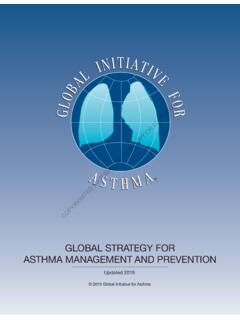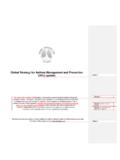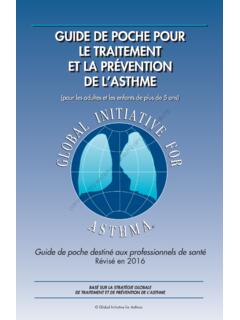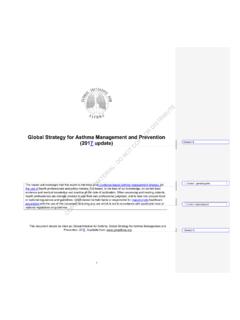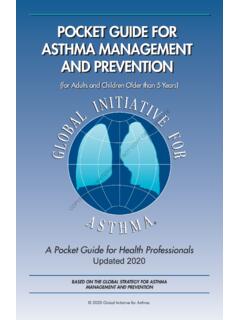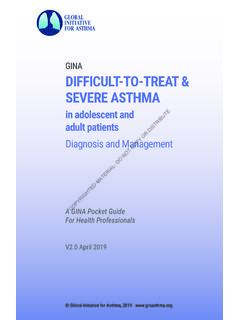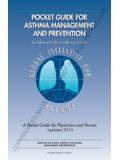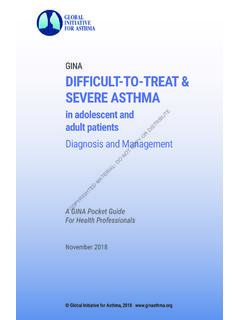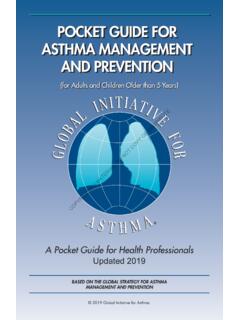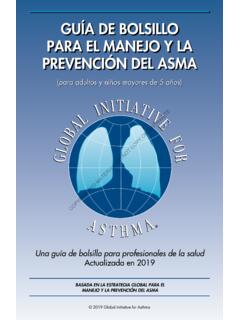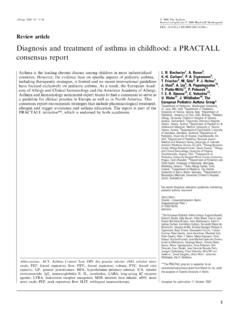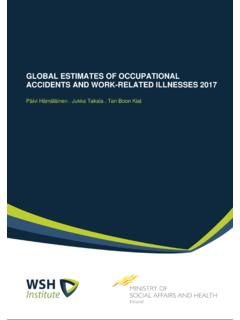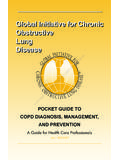Transcription of Global Strategy for Asthma Management and …
1 1 Global Strategy for Asthma Management and Prevention (2016 update) The reader acknowledges that this report is intended as a general guide for health professionals and policy-makers. It is based, to the best of our knowledge, on current best evidence and medical knowledge and practice at the date of publication. When assessing and treating patients, health professionals are strongly advised to use their own professional judgment, and to take into account local or national regulations and guidelines. GINA cannot be held liable or responsible for healthcare administered with the use of this document, including any use which is not in accordance with applicable local or national regulations or guidelines. This document should be cited as: Global Initiative for Asthma . Global Strategy for Asthma Management and Prevention, 2016.
2 Available from: Deleted: 5 Deleted: TDeleted: consult a variety of sources Deleted: and to use their own professional judgmentDeleted: 52 3 TABLE OF CONTENTS Preface .. 7 Members of GINA committees (2015) .. 8 Methodology .. 9 What s new in GINA 2016? .. 12 Peer-reviewed publications about the GINA report .. 12 SECTION 1. ADULTS, ADOLESCENTS AND CHILDREN 6 YEARS AND OLDER .. 13 Chapter 1. Definition, description, and diagnosis of Asthma .. 13 Definition of 14 Description of Asthma .. 14 Making the initial diagnosis .. 15 Differential diagnosis .. 20 Making the diagnosis of Asthma in special populations .. 21 Chapter 2. Assessment of Asthma .. 25 Overview .. 26 Assessing Asthma symptom control .. 27 Assessing future risk of adverse outcomes .. 31 Role of lung function in assessing Asthma control.
3 31 Assessing Asthma severity .. 33 Chapter 3. Treating Asthma to control symptoms and minimize risk .. 35 Part A. General principles of Asthma Management .. 36 Long-term goals of Asthma Management .. 36 The patient-health care provider partnership .. 37 Control-based Asthma Management .. 38 Part B. Medications and strategies for symptom control and risk reduction .. 40 Asthma medications .. 41 Reviewing response and adjusting treatment .. 47 Treating other modifiable risk factors .. 50 Other therapies .. 51 Non-pharmacological interventions .. 52 Indications for referral for expert advice .. 54 4 Part C. Guided Asthma self- Management education and skills training .. 55 55 Skills training for effective use of inhaler devices .. 55 Adherence with medications and other advice .. 56 Asthma information.
4 57 Training in guided Asthma self- Management .. 58 Part D. Managing Asthma with comorbidities and in special populations .. 61 Managing comorbidities .. 61 Managing Asthma in special populations or settings .. 64 Chapter 4. Management of worsening Asthma and exacerbations .. 71 73 Diagnosis of exacerbations .. 73 Self- Management of exacerbations with a written Asthma action plan .. 74 Management of Asthma exacerbations in primary care .. 77 Management of Asthma exacerbations in the emergency department .. 80 Chapter 5. Diagnosis of Asthma , COPD and Asthma -COPD overlap syndrome (ACOS) .. 87 Objective .. 88 Background to diagnosing Asthma , COPD and ACOS .. 88 Definitions .. 89 Stepwise approach to diagnosis of patients with respiratory symptoms .. 90 Future research .. 96 SECTION 2. CHILDREN 5 YEARS AND YOUNGER.
5 97 Chapter 6. Diagnosis and Management of Asthma in children 5 years and younger .. 97 Part A. Diagnosis .. 98 Asthma and wheezing in young children .. 98 Clinical diagnosis of Asthma .. 99 Tests to assist in diagnosis .. 101 Differential diagnosis .. 102 Part B. Assessment and Management .. 104 Goals of Asthma Management .. 104 Assessment of 104 Medications for symptom control and risk reduction .. 106 5 Reviewing response and adjusting treatment .. 110 Choice of inhaler device .. 110 Asthma self- Management education for carers of young children .. 111 Part C. Management of worsening Asthma and exacerbations in children 5 years and younger .. 112 Diagnosis of exacerbations .. 112 Initial home Management of Asthma exacerbations .. 113 Primary care or hospital Management of acute Asthma exacerbations.
6 115 Chapter 7. Primary prevention of Asthma .. 119 Factors contributing to the development of Asthma .. 120 Prevention of Asthma in children .. 120 Advice about primary prevention of Asthma .. 122 SECTION 3. TRANSLATION INTO CLINICAL PRACTICE .. 123 Chapter 8. Implementing Asthma Management strategies into health systems .. 123 Introduction .. 124 Adapting and implementing Asthma clinical practice guidelines .. 124 Barriers and facilitators .. 126 Evaluation of the implementation process .. 126 How can GINA help with implementation? .. 126 REFERENCES .. 127 6 BOXED TABLES AND FIGURES Box 1-1. Diagnostic flowchart for clinical practice initial presentation .. 16 Box 1-2. Diagnostic criteria for Asthma in adults, adolescents, and children 6 11 years .. 17 Box 1-3. Differential diagnosis of Asthma in adults, adolescents and children 6 11 years.
7 20 Box 1-4. Confirming the diagnosis of Asthma in a patient already taking controller treatment .. 22 Box 1-5. How to step down controller treatment to help confirm the diagnosis of Asthma .. 23 Box 2-1. Assessment of Asthma in adults, adolescents, and children 6 11 years .. 27 Box 2-2. GINA assessment of Asthma control in adults, adolescents and children 6 11 years .. 29 Box 2-3. Specific questions for assessment of Asthma in children 6 11 years .. 30 Box 2-4. Investigating a patient with poor symptom control and/or exacerbations despite treatment .. 34 Box 3-1. Communication strategies for health care providers .. 37 Box 3-2. The control-based Asthma Management cycle .. 38 Box 3-3. Population level versus patient level decisions about Asthma treatment .. 39 Box 3-4. Recommended options for initial controller treatment in adults and adolescents.
8 42 Box 3-5. Stepwise approach to control symptoms and minimize future risk .. 43 Box 3-6. Low, medium and high daily doses of inhaled corticosteroids .. 44 Box 3-7. Options for stepping down treatment once Asthma is well controlled .. 49 Box 3-8. Treating modifiable risk factors to reduce exacerbations .. 50 Box 3-9. Non-pharmacological interventions - Summary Summary .. 52 Box 3-10. Indications for considering referral for expert advice, where available .. 54 Box 3-11. Strategies to ensure effective use of inhaler devices .. 55 Box 3-12. Poor medication adherence in Asthma .. 57 Box 3-13. Asthma information .. 58 Box 3-14. Investigation and Management of severe Asthma .. 70 Box 4-1. Factors that increase the risk of Asthma -related 73 Box 4-2. Self- Management of worsening Asthma in adults and adolescents with a written Asthma action plan.
9 75 Box 4-3. Management of Asthma exacerbations in primary care (adults, adolescents, children 6 11 years) .. 78 Box 4-4. Management of Asthma exacerbations in acute care facility, emergency department .. 81 Box 4-5. Discharge Management after hospital or emergency department care for Asthma .. 86 Box 5-1. Current definitions of Asthma and COPD, and clinical description of ACOS .. 89 Box 5-2a. Usual features of Asthma , COPD and ACOS .. 91 Box 5-2b. Features that if present favor Asthma or COPD .. 91 Box 5-3. Spirometric measures in Asthma , COPD and ACOS .. 93 Box 5-4. Summary of syndromic approach to diseases of chronic airflow limitation .. 95 Box 5-5. Specialized investigations sometimes used in distinguishing Asthma and COPD .. 96 Box 6-1. Probability of Asthma diagnosis or response to Asthma treatment in children 5 years and younger.
10 99 Box 6-2. Features suggesting a diagnosis of Asthma in children 5 years and younger .. 100 Box 6-3. Common differential diagnoses of Asthma in children 5 years and younger .. 103 Box 6-4. GINA assessment of Asthma control in children 5 years and younger .. 105 Box 6-5. Stepwise approach to long-term Management of Asthma in children 5 years and younger .. 109 Box 6-6. Low daily doses of inhaled corticosteroids for children 5 years and younger .. 110 Box 6-7. Choosing an inhaler device for children 5 years and younger .. 111 Box 6-8. Primary care Management of acute Asthma or wheezing in children 5 years and younger .. 114 Box 6-9. Initial assessment of acute Asthma exacerbations in children 5 years and younger .. 115 Box 6-10. Indications for immediate transfer to hospital for children 5 years and younger.
